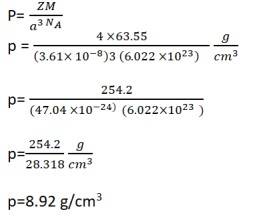
Salviya AntonySenior Executive - Content
Lattice points are imaginary points in space which represent the positions of particles in a crystal lattice. These particles can be atoms, ions, or molecules, depending on the type of crystal. A lattice is defined as an ordered set of points that define the structure of a crystal-forming particle. The lattice points identify the unit cell of a crystal.
The Unit cell corner is described by a lattice point where the crystal contains an atom, ion, or molecule. The cubic unit cell centred on the body is the simplest repeating unit in a cubic structure centred on the body. The points in a crystal lattice in the model crystal denote the positions of structural units i.e atoms, molecules or ions. Every lattice point in the crystal has the same surroundings as the actual crystal structural units.
Importance of Lattice Points
Lattice points are essential since they provide a systematic way to describe the three-dimensional arrangement of particles in a crystal. This arrangement is critical in understanding the physical and chemical properties of solids. Lattice is a regular repeated 3D arrangement of atoms, ions, or molecules in a crystalline solid. Each point in a lattice is called a lattice point. Lattice point represents the constituent particle of a solid which may be an atom or a molecule.
Types of Lattice Points
There are primarily three types of lattice points:
Primitive Lattice Points: These points represent the positions of the smallest repeating unit, called the unit cell, in a crystal lattice.
Face-Centered Lattice Points: These points are found at the center of each face of the unit cell and are often associated with cubic unit cells.
Body-Centered Lattice Points: These points are located at the center of the unit cell and are commonly found in body-centered cubic (BCC) unit cells.
Types of Crystal Lattices
Let us learn about different types of crystal lattices, including:
- Simple Cubic (SC) Lattice
- Body-Centered Cubic (BCC) Lattice
- Face-Centered Cubic (FCC) Lattice
Simple Cubic (SC) Lattice
In the simple cubic structure there is only one lattice point at each corner of the cube-shaped unit cell.
Body-Centered Cubic (BCC) Lattice
A BCC unit cell has atoms at each corner of the cube and an atom at the centre of the structure. Body-centered cubic (BCC) is defined as a crystal structure that consists of a cube-shaped unit cell with atoms located at the corners and in the center of the cube. In this structure, each atom is surrounded by eight nearest neighbours located at the corners of the cube.
Face-Centered Cubic (FCC) Lattice
An FCC unit cell has atoms at all the corners of the crystal lattice and at the centre of all the faces of the cube. The atom present at the face-center is shared between 2 adjacent unit cells and only 1/2 of each atom belongs to an individual cell.
Coordination Number
In the context of lattice points, the coordination number represents the number of nearest neighboring particles to a given lattice point. Different types of lattices have different coordination numbers.
Crystal Systems
Lattice points and unit cells are used to classify crystals into seven crystal systems, which are further categorized based on the angles and lengths of their unit cell edges. These systems include cubic, tetragonal, orthorhombic, monoclinic, triclinic, hexagonal, and rhombohedral (trigonal) systems.
FAQs on Lattice Points
Q: How many lattice points are there in one unit cell of each of the following lattice? (i) Face-centred cubic (ii) Face-centred tetragonal (iii) Body-centred
A:
Number of corner atoms per unit cell
= 8 corners atoms ×18 atom per unit cell
=8 × 18 = 1 atom
Number of face face centred atoms per unit cell
= 6 face centred atoms × 12 atom per unit cell
= 6 × 12 = 3 atoms
∴ Total number of atoms (lattice point) = 1 + 3 = 4
(ii) As in (i)
No. of lattice points = 4
(iii) In bcc unit cell, number of corner atoms per unit cell
=8 corners×18 per corner atom
=8×18=1 atom
Number of atoms at body centre =1×1 = 1 atom
∴ Total number of atoms (lattice points) = 1 + 1 = 2
Q: Copper crystallises into a fcc lattice with edge length 3.61 × 10^–8 cm. Show that the calculated density is in agreement with its measured value of 8.92 g cm^–3.
A:

Q: Analysis shows that nickel oxide has the formula Ni0.98 O1.00. What fractions of nickel exist as Ni2+ and Ni3+ ions?
A:
t is given that nickel oxide has the formula as Ni0.98 O1.00.
As per the formula, there are 98 Ni ions for 100 oxide ions.
Out of 98 Ni ions, let x ions be in +2 oxidation state
98−x ions will be in +3 oxidation state.
Oxide ion has −2 charge.
To maintain electrical neutrality, total positive charge on cations = total negative charge on anions.
2x+3(98−x)+100(−2)=0
x=94
Fraction of Ni2+ ions = 94/98 = 0.96
Fraction of Ni2+ ions = 98-94/98 = 0.04
Hence, the fractions of nickel that exists as Ni2+ and Ni3+ are 0.96 and 0.04 respectively
News & Updates
Atoms and Molecules Exam
Student Forum
Popular Courses After 12th
Exams: BHU UET | KUK Entrance Exam | JMI Entrance Exam
Bachelor of Design in Animation (BDes)
Exams: UCEED | NIFT Entrance Exam | NID Entrance Exam
BA LLB (Bachelor of Arts + Bachelor of Laws)
Exams: CLAT | AILET | LSAT India
Bachelor of Journalism & Mass Communication (BJMC)
Exams: LUACMAT | SRMHCAT | GD Goenka Test